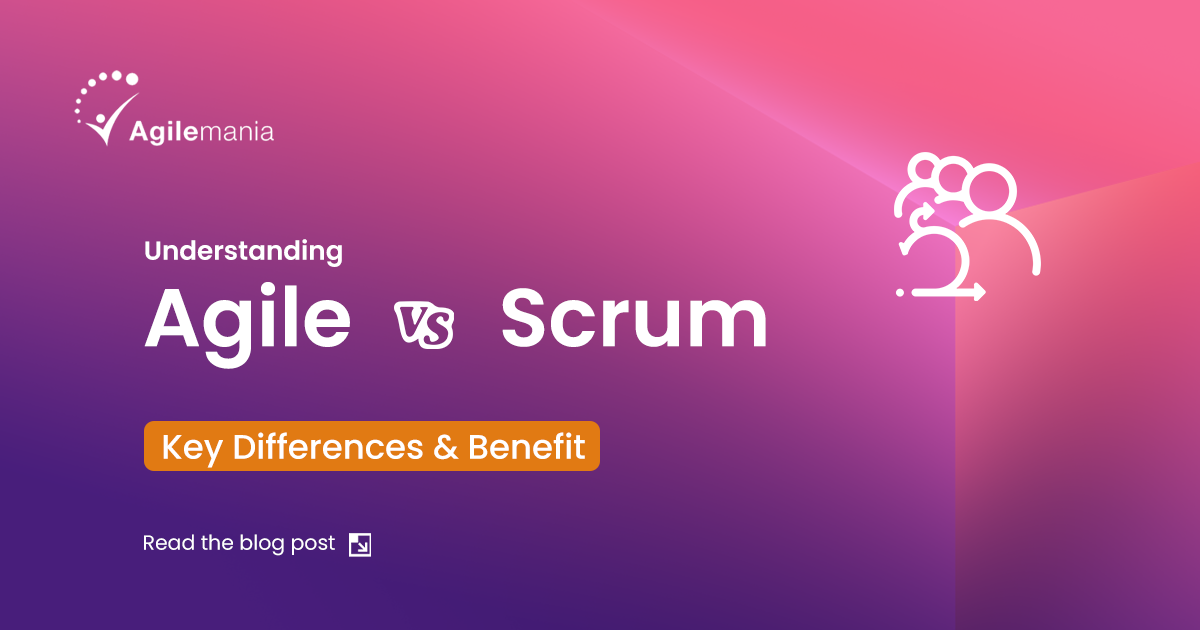
Naveen Kumar Singh
Naveen is a professional agile coach and has been working independently for a long time in the Asia... Read more
![]() Get Your AI-Enabled Scrum Master Certification for Just ₹1,500 (Save 85%)!
Get Your AI-Enabled Scrum Master Certification for Just ₹1,500 (Save 85%)!
Scrum.Org
SAFe®
ICAgile
Scrum Alliance
Technical Agility
Kanban
Business Analysis
Project Management
AI-Enabled
Agilemania Academy
Scrum.Org
SAFe®
ICAgile
Scrum Alliance
Technical Agility
Kanban
Business Analysis
Project Management
AI-Enabled

Naveen Kumar Singh
Naveen is a professional agile coach and has been working independently for a long time in the Asia... Read more

Have you ever felt lost when you hear the term agile vs scrum?
Don't worry; you're not alone. Many people got confused when comparing Agile and Scrum and why they matter.
Many people use Agile and Scrum interchangeably, but they are not exactly the same thing.
Agile is an umbrella term for various iterative development methods, while Scrum is a specific agile framework with clearly defined roles and processes.
Understanding the distinctions can help teams determine which approach may work best for their projects and organization.
In this blog, we’ll break down the core principles and practices of Agile and Scrum development to help highlight their similarities and differences.
We’ll look at topics like organizational structure, team roles, planning methods, and key ceremonies or meetings.
Whether you’re new to these project management styles or looking to refresh your knowledge, this blog hopefully will provide some helpful context to help you decide if Agile or Scrum (or a combination) aligns best with your business objectives!
To comprehend the difference between Agile and Scrum, first, we must have a better understanding of-
What is Agile? And What is Scrum?
Agile is an approach/methodology that assists us in the constant iteration of processes of the Software Development Life Cycle, such as development, testing, etc.
This methodology has established several benefits, such as delivering high-value features in short delivery cycles, which were otherwise challenging in the conventional waterfall approach.
Agile aids to enhance customer retention and satisfaction.
This is achieved by breaking down the product into relatively smaller units/builds, resulting in making the activities concurrent.
Agile advances teamwork and in-person communication.
When it comes to implementing Agile methodologies, there isn't a one-size-fits-all approach.
There may be a variety of strategies tailored to the needs and circumstances of different teams and organizations that succeed.
Here are several approaches commonly used to implement Agile:
Scrum
Kanban
Feature Driven Development (FDD)
Extreme Programming (XP)
Lean Software Development (LSD)
Adaptive System Development (ASD)
Dynamic Systems Development Method (DSDM)
Crystal
Scrum is a framework within which people can address complex adaptive problems, while productively and creatively delivering products of the highest possible value.
Understanding how Scrum works is like following a map on a trip – once you know the way, you'll get to where you want to go faster. Here's a simple guide to how Scrum works:
Product Backlog: The Product Backlog is where all the requirements, features, enhancements, and fixes for a product are captured. It serves as a dynamic document that evolves throughout the project, reflecting changes in priorities and stakeholder needs. Having a well-maintained Product Backlog ensures transparency, alignment, and focus on delivering value to the customer.
Sprint Planning: Sprint Planning sets the direction for the upcoming sprint by determining which items from the Product Backlog will be worked on and how they will be delivered. It facilitates collaboration between the product owner, development team, and Scrum Master to establish a shared understanding of the sprint goal, scope, and deliverables. Effective Sprint Planning ensures the team is aligned and committed to achieving the sprint's objectives.
Backlog Refinement (recommended): Backlog Refinement involves continuously refining and prioritizing items in the Product Backlog to ensure they are ready for Sprint Planning. It allows the team to clarify requirements, estimate effort, and identify dependencies, reducing ambiguity and improving predictability. By investing time in backlog refinement, teams can ensure smoother Sprint Planning sessions and increase their capacity for delivering value.
Daily Scrum: The Daily Scrum, also known as the Daily Standup, is a short, time-boxed meeting where team members synchronize their activities, discuss progress, and identify any impediments. It promotes transparency, collaboration, and accountability by allowing the team to inspect and adapt their plan daily. The Daily Scrum keeps the team focused, enables early detection of issues, and fosters a culture of continuous improvement.
Sprint Review: The Sprint Review is a collaborative meeting where the Scrum Team demonstrates the increment of work completed during the sprint to stakeholders and gathers feedback. It provides an opportunity to inspect the product increment, gather insights, and adapt the Product Backlog based on stakeholder input. The Sprint Review ensures transparency, alignment with customer needs, and opportunities for course correction.
Sprint Retrospective: The Sprint Retrospective is a structured reflection meeting where the Scrum Team discusses what went well what could be improved, and identifies action items for the next sprint.
It fosters a culture of continuous improvement by enabling the team to reflect on their processes, identify bottlenecks, and implement changes to enhance their effectiveness.
The Sprint Retrospective promotes accountability, teamwork, and a commitment to delivering better outcomes with each sprint.
Overall, each step in the Scrum process is vital in promoting transparency, collaboration, and continuous improvement, ultimately enabling teams to deliver value to their customers efficiently and effectively.
Agile |
Scrum |
| Agile is a development methodology that follows an incremental and developmental approach | Scrum is one of the frameworks of Agile. It follows an iterative and incremental approach called sprints which lasts 2-3 weeks |
| Agile works best for organizations which small but experienced development teams | Scrum is best suited for projects where requirements keep changing |
| Leadership plays a key role in Agile | Scrum supplements a self-organizing and cross-functional team |
| Lacks flexibility when compared to Scrum | Scrum’s flexibility is its biggest strength since it can adapt to changes quickly |
| Open communication is the norm in Agile where face to face interactions happen between cross functional teams | Daily stand up meetings are held where Scrum Master, Product Owner, and the team members |
| Agile needs a lot of structural and developmental changes before the start | Not many changes are required when applying Scrum |
| The client feedback loop should be regular in | The client is asked for feedback after every sprint for review |
| In Agile methodology, each phase of the development process like requirements, analysis, and design is tracked regularly | A demo is given to the client after every sprint for feedback |
| The Project head oversees the tasks and is the decision-maker | The team has no leader so the entire team resolves issues and tasks |
| Design and implementation should be simple | Innovation should drive design and implementation |
| Continuous delivery of the working product is the priority in Agile | Empirical process control is followed in scrum |
| Functional software is the measure of progress | Functional software is the measure of progress |
Unlock your potential as a Scrum Master and drive your team towards success. Schedule a consultation and discover how we can help you achieve your goals.
Contact Us Today!
The Agile methodology is one of the most successful and productive means to drive your organization ahead, implement and deliver values. Several giant software companies across the globe have embraced this framework to attain digital transformation. You can become Agile or learn more about Agility by enrolling in our classes conducted by our consultant or visit our schedule.
Agile is a development methodology based on iterative and incremental approach. Scrum is an implementation of agile methodology in which incremental changes are delivered timely.
When considering Agile vs. Scrum methodologies, it's essential to assess your project's specific needs and objectives. Agile offers flexibility and adaptability, ideal for rapidly changing environments. On the other hand, Scrum provides a structured framework with defined roles and processes, suitable for projects requiring clear direction and accountability. Evaluate your project requirements carefully to choose the methodology that aligns best with your goals and team dynamics.
Think of Scrum as a special tool in the big toolbox called Agile. Agile is like a way of thinking about managing projects, and Scrum is one of the methods you can pick from to put that thinking into action. Scrum has some parts that fit right into the Agile way of doing things, but it also has its own special features that set it apart.
Agile is like a big idea about how to work on projects flexibly and collaboratively, while Scrum is one specific way to do Agile. So, Agile is the main idea, and Scrum is one method that follows that idea closely.
Naveen is a professional agile coach and has been working independently for a long time in the Asia Pacific. He works with the software development team and product team to develop awesome products based on empirical processes.
WhatsApp Us

We will get back to you soon!
For a detailed enquiry, please write to us at connect@agilemania.com

